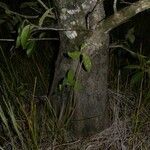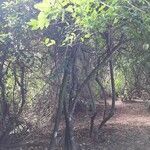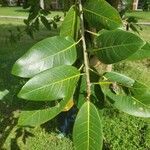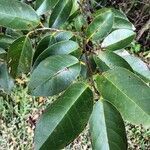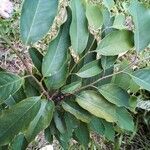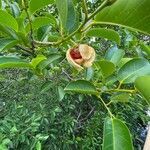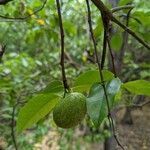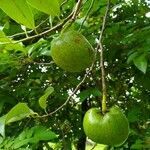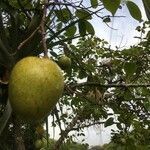Shrubs or trees , to ca. 15 m; trunks commonly buttressed at base. Principal leaves late deciduous; petiole 10-20mm. Leaf blade ovate to elliptic, 5-15 × 6(-8) cm, base broadly cuneate to rounded, apex acute to short-acuminate; surfaces glabrous. Inflorescences from leaf axils on new shoots, solitary flowers; peduncle stout, linear, club-shaped, to 2cm, becoming enlarged. Flowers: sepals reniform-cordate, 5-6 mm, glabrous; outer petals cream-white, ovate-cordate, adaxially concave, 2.5-3 cm, apex acute; inner petals cream-white, inside base deep purple, oblong-ovate, 2-2.5 cm, base cupped, incurved-cuneate, at least 2×3 length of outer petals, corrugate; stamens linear, 3-4 mm; connective thickened above anther tip; pistils conically massed, connate. Syncarp pendulous on thickened peduncle, dull yellow blotched with brown, ± ovoid, 5-12 cm, smooth with reticulate pattern formed by pistil boundaries. Seed ellipsoid to obovoid, 1-1.5 cm. 2 n =28.
A tree up to 10 metres high; branchlets very soon glabrous. Leaves on petioles 1.0-1.5(-2.5) cm. long, rather thin, pale green, ovate-elliptic or oblong-elliptic, rotundate or acute and decurrent at the base, shortly acute or rarely obtuse at the apex, 7-14 cm. long and 3-8 cm. broad; network of veins dense and nicely prominent on both sides. Flowers solitary, issuing from about the middle of the internodes below the leaves; pedicels 1.5-2.0 cm. long, glabrous. Sepals rotundate, apiculate, 3-5 mm. long. Petals glabrous on outside, the outer ovate, 2.5-3.0(-4.0) cm. long, the inner a little smaller. Stamens 3-4 mm. long, connective disk broad, papillose but not setose. Fruit globose-ovoid, rounded at the top, 7-12 cm. long, smooth, areoles hardly obvious.
Tree to 10 m high. Axillary buds ovoid, obtuse, pubescent; shoots glabrescent. Leaves: petiole 9–18 mm long; lamina elliptic or ovate, 7–15 cm long, 3–8 cm wide, obtuse or shortly decurrent at base, acuminate at apex, glabrous; secondary veins 8–12 pairs. Flowers solitary, internodal or terminal; pedicel 15–20 mm long. Sepals very broadly to depressed ovate, 3–4 mm long and wide, acuminate. Petals 6, broadly ovate, greenish yellow. Outer petals 15–30 mm long, 13–25 mm wide, puberulous inside. Inner petals 12–25 mm long, 7–15 mm wide, puberulous, red inside. Stamens 3–4 mm long. Carpels connate. Syncarpium ovoid, 5–12 cm long, 5–8 cm wide, smooth, dull brownish yellow. Seeds 13–15 mm long, 9–10 mm wide.
A small to medium sized tree. It grows 6-12 m high. The leaves are simple and 6-25 cm long. They are alternate. They vary in size. The flowers occur singly. The fruit is large and yellow. It is 70-80 mm across. They occur single in the axils of leaves. There are several seeds inside. These are about 12 mm long. The flesh is orange when ripe and edible.
Fruits smooth, yellowish when ripe.
A small tree or shrub
Flower white
